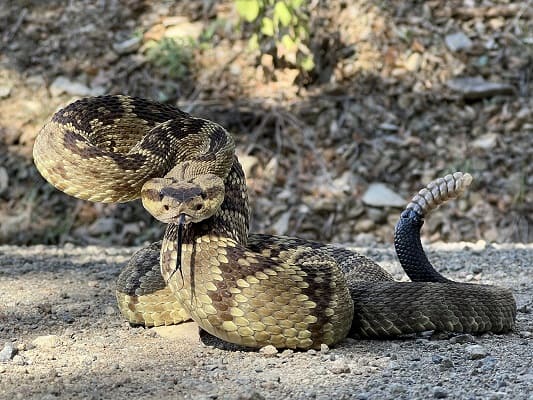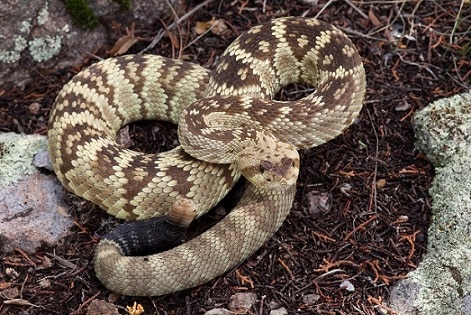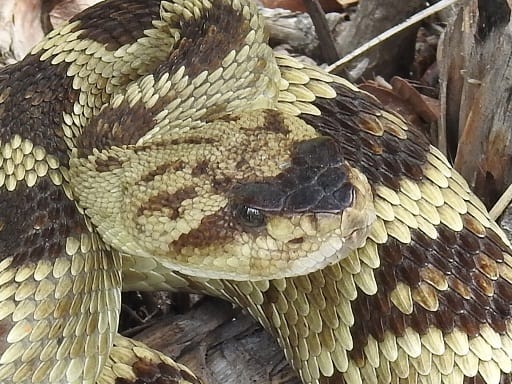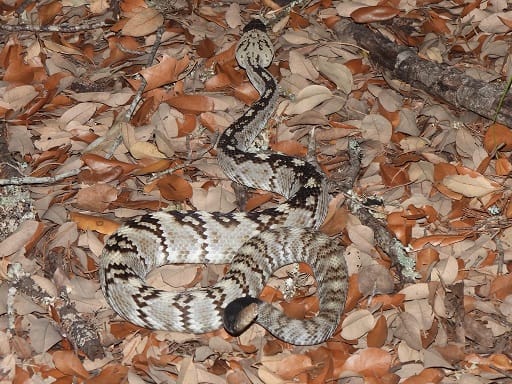| 1 | Easily recognisable |

The black-tailed rattlesnake is a medium-sized species found in the far southern US, plus a large swathe of Mexico. It’s flexible in its habitats, appearing in semi-deserts, pine-oak forests, and rocky mountainous slopes, while avoiding human inhabited areas. Black-tailed rattlesnakes inhabit the whole of Arizona, and overlap with many of their cousins. In Tonto National Monument, they live alongside west diamondbacks and Arizona black rattlesnakes. In Saguaro National Park, they coexist with tiger rattlesnakes and west diamondbacks once again.
Despite this, there’s always a simple way to identify this rattlesnake: the black tail. Their main body varies in colour. Beige-black is the norm, with some having bright yellow or whiter tones. But the black tail is constant, and rather than a sudden change, this tail darkens gradually from the beige body, before reaching full midnight intensity. At the tail tip, the black transitions suddenly to beige for the musical segmented rattle scales.
This ID sign makes this species one of the easier rattlesnakes to identify, even for an amateur enthusiast. Black-tailed rattlesnakes reach a record length of 152.4cm, versus 91.2cm for the tiger rattlesnake, and 233.7cm for the west diamondback.
| 2 | Black tail, yellow venom |

The black-tailed rattlesnake has never caused a confirmed human death on record. The western diamondback has killed 5-10 Americans since 2000, but the black-tail has killed 0 people since 1900. Part of the reason is their calm demeanour, as black-tails will commonly let people pass without even rattling (except when guarding babies). They default to camouflage rather than aggressive assault, staying still and attempting to blend with undergrowth.
Their venom is also relatively mild. The LD50 toxicity score is approximately 2.5mg, versus 0.06mg for a tiger rattlesnake. Black-tails belong to the type I rattlesnake class: those with virtually no neurotoxins and an abundance of haemotoxins and cytotoxins instead. If bitten by Crotalus molossus, perhaps after springing from a boulder by a hiking trail, you can expect painful swelling, mild spontaneous bleeding, random bruising, and tenderness of the affected limb.
Black-tails have a decent venom yield to compensate for their weak venom, averaging at 286mg per bite. Another characteristic is a yellow venom, versus transparent for a tiger rattlesnake.
| 3 | Expect swelling and numbness |
Medical bite reports are rare for the black-tailed rattlesnake, and the most detailed so far involved a 12 year old girl. She was in her backyard at 8:00am when a rattlesnake suddenly bit her right foot, between her first and second toes. Discomfort began rapidly, followed by spreading edema (swelling). After applying ice and a tourniquet, the girl reached hospital at one hour post bite, where she was given 4 vials of antivenom. She was experiencing mild pain and her knee was numb and tingling, while systemic symptoms such as nausea, vomiting and chest pain were lacking.
By this stage, the swelling covered her foot and ankle and was slowly spreading to the lower third of her leg. By 1pm (5 hours post bite), this reached her mid-calf, and by 23 hours post bite (7am the following day), it extended past the knee. The girl’s leg showed no sign of haemorrhagic blisters or necrosis, the spontaneous death of healthy tissue, but her foot remained numb. The next day, the swelling finally lessened.
The picture is of a rattlesnake with dangerous but easily survivable effects, although the story might have been different without antivenom. The 12 year old girl was presumably smaller than the average victim, so with more area for the venom to cover, an adult could expect slightly less severe effects.
| 4 | Capable of destroying capillaries |

Though no deaths are confirmed for black-tailed rattlesnakes, scientists believe that deaths could be possible in exceptional circumstances. For example, a 2014 study tested the effect of Crotalus molossus venom on the brain’s blood vessels. Rats were injected with the venom in their lower limbs, at dosages varying from 0.02 to 0.20mg/kg.
At higher doses, the quantity of capillaries in the brain was significantly reduced, while existing capillaries haemorrhaged and suffered severe structural damage. This was attributed to metalloproteinases in the venom, which assault structural elements of blood vessels like laminin and type 4 collagen. Stroke may be possible after a black-tailed rattlesnake bite.
While possessing the blood chaos profile of many rattlesnakes, the black-tail is tilted more towards spontaneous haemorrhaging. It’s able to destroy clotting factors like fibrinogen, but more weakly than others. This is also a rattlesnake whose venom transforms with age. A 2018 study found that younger black-tails produce more crotamine in their venom, a myotoxin which assaults muscle tissue, and had stronger procoagulant properties. Adults had a more strongly proteolytic venom, the toxins behind the severe swelling. All ages had strong haemorrhagic powers. They also tested Mexican antivenoms, and found poor effectiveness against the juvenile black-tail venom due to this altered profile.
| 5 | Most common on rocky slopes |
Black-tailed rattlesnakes are flexible, but all signs suggest that they gravitate towards rocky areas, whether in semi desert or forested national parks. A 1995 study analysed 3 rattlesnakes living side by side, in the Tucson mountain foothills of Arizona: black-tailed, west diamondback and tiger rattlesnakes.
The west diamondbacks preferred desert flats covered with creseote bushes, while tiger rattlesnakes appeared mainly on rocky slopes and desert washes. The black-tailed rattlesnakes had a strong correlation with steep rocky slopes. The frequency of detection on rocky slopes was 65% for black-tails and 20% for west diamondbacks. The frequency for creseote (larrea) bush flats was 10% for black-tails, versus 60% for west diamondbacks. Blacktails were almost completely found in rocky areas until summer and autumn, when they became more flexible. West diamondbacks were almost completely found in Larrea desert flats in spring.
Black-tails have even been found in caves before, as well as canyon edges and rocky outcrops within pine-oak forests. From March 1st to October 15th, the black-tailed rattlesnakes travelled an average of 42.9 metres per day. This was intermediate, as west diamondbacks moved 50.8 m/d, and the tiger rattlesnakes 32.9 m/d.
| 6 | Dislikes flat, open spaces |

Another study compared west diamondbacks, black-tails and Arizona black rattlesnakes in Tonto National Monument, Arizona. It found that while black-tailed rattlesnakes occupied many habitats, they were rarely found near buildings. Again, the black-tails loved steep rocky slopes, and inhabited the steepest slopes of the 3 species. 89% of their hibernation sites were on steep slopes covered with mixed jojoba scrub.
Like Arizona black rattlesnakes, the black-tails preferred upland habitats with denser vegetation. They stuck to areas with a much higher canopy cover compared to west diamondbacks, which preferred open spaces. Crotalus molossus was heavily associated with boulders, mosses, lichens and rocky outcrops.
This is mainly a diurnal (day-faring) species, which only becomes nocturnal during summer in hot locations. In most locations, they become crepuscular during the summer and are active from 8:00-10:00 and 16:00 to 22:00. The Tonto National Monument study found that black-tails had the longest active season of the 3 rattlesnakes. They consistently entered hibernation the latest and left the earliest, while Arizona black rattlesnakes were the reverse. This is a hardy snake which has been spotted slithering around in late November amid a thin covering of snow. On warm winter days in January, they may emerge from their rock crevice or mammal burrow and lazily bask in the sun.
| 7 | Viciously defends its young |
Rattlesnakes vary in their parental love; red diamond rattlers show no maternal care whatsoever, while timber rattlesnakes stay with their offspring for over a week. Black-tailed rattlesnakes may be in the caring category, according to a September 1984 tale from Tanque Verde Creek, northeast of Tucson, Arizona. The reptile enthusiast was passing through a ravine when he heard a loud hiss, and was surprised to see an aggressive black-tailed rattlesnake approaching from a large rock. It stopped 10 feet away, and stared down the author for 10 to 15 seconds. It then retreated, and the author eagerly followed, but the aggressive black-tail took notice again and resumed its determined charge. This time it stopped just 6 feet away.
The author learnt his lesson, and allow the black-tail to fully retreat to its rock, where it vanished into a dark crevice. The author approached cautiously, peered inside the crevice, and discovered several neonate black-tails, which were likely just a few days old as they had yet to shed their skin. The female adult black-tail was unusually thin. The mother had clearly been defending its young, particularly given that this is normally a calm species.
The author continued to observe, and watched as a neonate left the crevice and began exploring. The mother took no chances, and after slithering up to its child, used its bulky body to pin it to the floor, keeping it out of danger.
| 8 | Diet: mainly mammals |
One interesting statistic is that Crotalus molossus must eat 93% of its BMI to fulfil its annual energy requirements. Supposedly, this can be achieved in just 2 to 3 large meals. Black-tailed rattlesnakes are mainly a mammal muncher, unlike the lizard preferences of the ridge-nosed rattlesnake. The most detailed study so far came from Chihuahua state, Mexico. It found a dietary breakdown of 8.3% Neotoma woodrats, 25% Peromyscus deer mice, 33.3% Perognathus pocket mice, 16.7% Dipodymus kangaroo rats, and 16.7% birds.
Many specific meals have been confirmed…
Birds: black throated sparrow, western bluebird.
Rodents: white-throated woodrats, silky pocket mouse, rock pocket mouse, black rat, Merriam’s kangaroo rat, cactus mouse, eastern deer mouse, white ankled mouse.
Other mammals: pallid bat, desert cottontail rabbit, rock squirrel, cliff chipmunk.
The occasional lizard has been confirmed, such as the Gila monster. Crotalus molossus uses the classic viper trick of envenomating its prey, standing back, and scent tracking its prey using the molecules it has just injected. One was observed following a bitten rabbit for 90 metres. They’re not strict about their hunting style, using both ambush and active foraging. In ambush, they coil into an S-shape with their tail hidden in undergrowth, typically on the edge of a well-trodden mammal runway or trail.
| 9 | Can exceed 20 years old |
Like the timber rattlesnake, black-tail couples are more loving than the average snake. One male-female pair was radiotagged after being found in a woodrat den together. For several weeks, they stuck by each other’s sides, before going their separate ways in early autumn.
Among 30 litters reported for black-tailed rattlesnakes, the range was 3-16 young, with an average of 5.6. With a sample size of 25, neonates ranged in length from 22.9 to 31.8cm. Younglings can hunt giant prey within days; this report mentioned a 20 gram black-tail juvenile aged 3 weeks swallowing a 26 gram brush mouse (Peromyscus boylii). The same study found that black-tailed rattlesnakes return to the same hibernation sites repeatedly. Two males stayed in the same dark refuges for 7 years straight. Some black-tails moved up to 1.5km to find summer feeding grounds.
The record age for Crotalus molossus is unknown, but one adult caught in the wild lasted another 20 years, 8 months and 24 days, in its Columbus Zoo, Ohio home. Aside from the tail, Crotalus molossus can be recognised by dark, diagonal markings on their face and snout, which contrast sharply with a beige/yellow undertone. Neither west diamondbacks nor tiger rattlesnakes have such markings. In fact, those two have less sharply contrasting body patterns overall.
| 10 | The convoluted family tree |

In 2012, a schism occurred in the black-tailed rattlesnake empire. Those in Texas and eastern New Mexico were once considered to be a subspecies, but genetic analysis revealed them to be a far more distinct lineage than once believed, a separation possibly caused by the uprising of the Sierra Madre Occidental plateau millions of years ago.
Thus they became a fully independent species – the eastern black-tailed rattlesnake (Crotalus ornatus). Those in western New Mexico and Arizona remained with the original species (Crotalus molossus), as did most in Mexico, including the southernmost versions near Mexico City.
Both species have the signature dark tail, and highly contrasting dark patterns against light. The main difference was that in the eastern species, the first 6-10 dark blotches below the head are connected (see above), while in the western Crotalus molossus, there’s usually a single pale scale inbetween. There was also subtle differences in scale counts, such as 3 loreal scales versus 4 in the western species. If you meet a black-tailed rattlesnake near your family ranch in a Texas canyon, it’s actually the new Crotalus ornatus.
